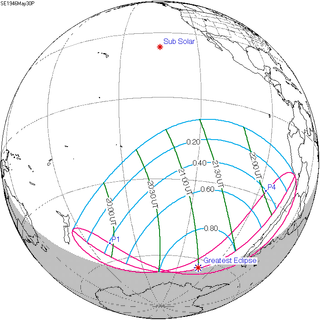| Solar eclipse of May 30, 1946 | |
|---|---|
| Type of eclipse | |
| Nature | Partial |
| Gamma | −1.0711 |
| Magnitude | 0.8865 |
| Maximum eclipse | |
| Coordinates | 64°06′S 101°00′W / 64.1°S 101°W |
| Times (UTC) | |
| Greatest eclipse | 21:00:24 |
| References | |
| Saros | 117 (65 of 71) |
| Catalog # (SE5000) | 9390 |
A partial solar eclipse occurred at the Moon's ascending node of orbit on Thursday, May 30, 1946,[1] with a magnitude of 0.8865. A solar eclipse occurs when the Moon passes between Earth and the Sun, thereby totally or partly obscuring the image of the Sun for a viewer on Earth. A partial solar eclipse occurs in the polar regions of the Earth when the center of the Moon's shadow misses the Earth.
This was the second of four partial solar eclipses in 1946, with the others occurring on January 3, June 29, and November 23.
A partial eclipse was visible for parts of eastern Oceania and western South America.
- ^ "May 30, 1946 Partial Solar Eclipse". timeanddate. Retrieved 4 August 2024.
